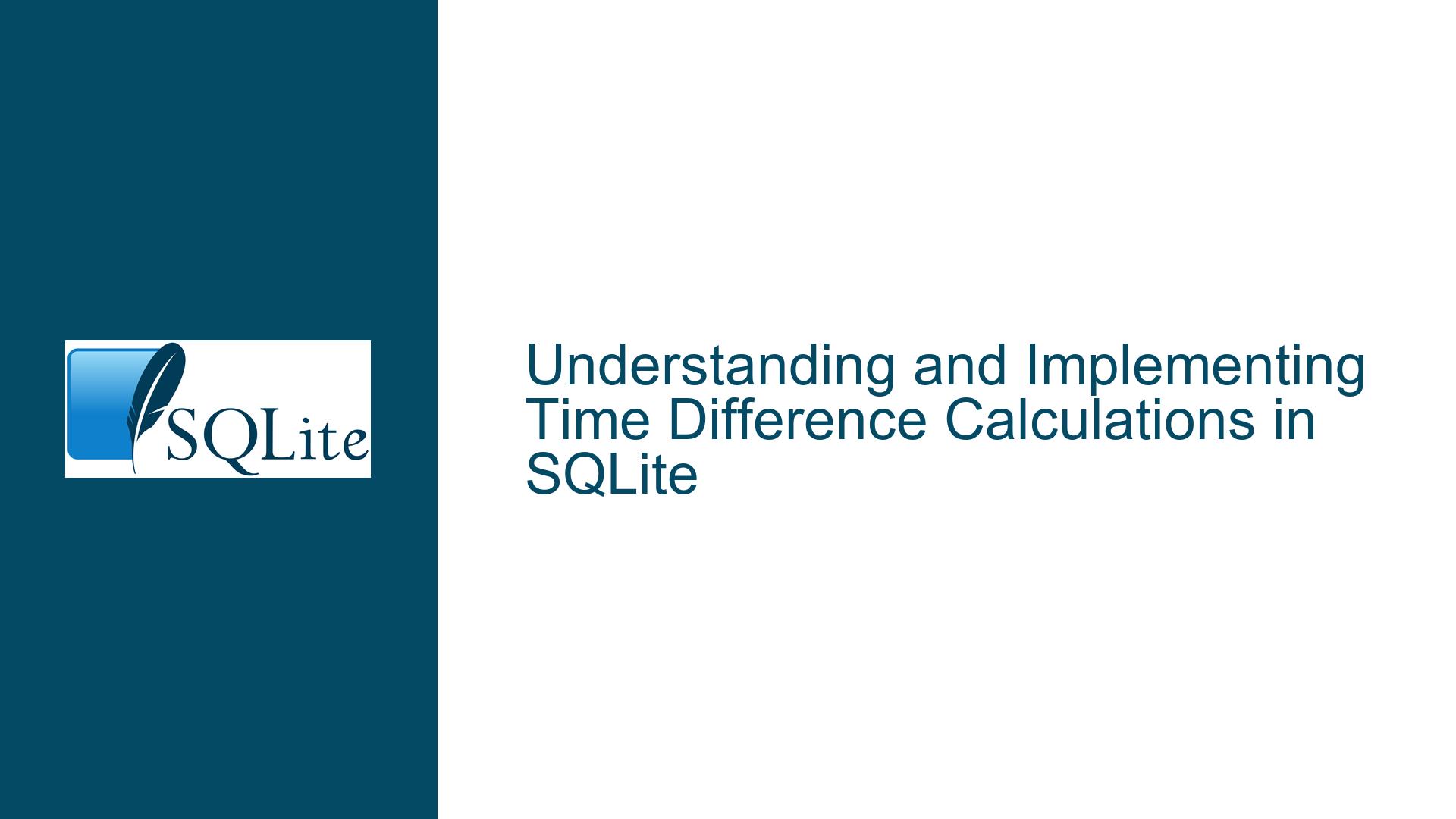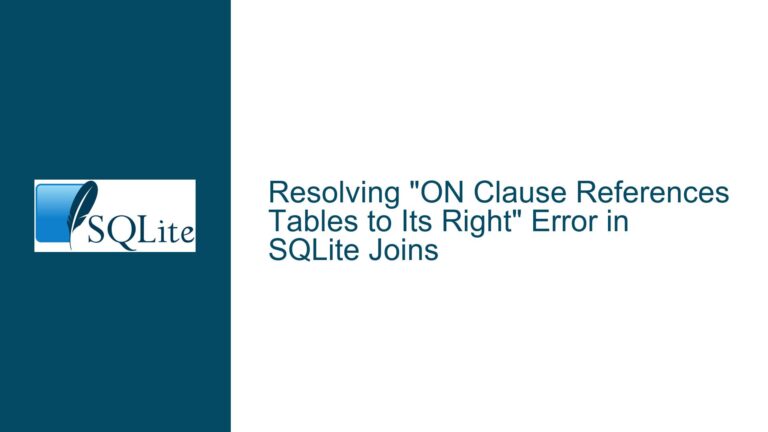and Implementing Time Difference Calculations in SQLite
The Need for Human-Readable Time Differences in SQLite
When working with databases, particularly SQLite, one common requirement is the ability to calculate and display time differences in a human-readable format. This need arises in various applications, such as tracking project durations, monitoring system uptimes, or analyzing event logs. While SQLite provides robust date and time functions, it lacks a built-in function specifically designed to compute time differences in a format that accounts for the irregularities of the Gregorian calendar, such as varying month lengths and leap years.
The absence of a timediff() function in SQLite can be a significant hurdle for developers who need to present time differences in a way that is immediately understandable to end-users. For instance, calculating the difference between two dates in terms of years, months, and days requires more than a simple subtraction of Unix timestamps or Julian day numbers. This is because the duration between two dates can vary depending on the specific months and years involved, due to factors like February having 28 or 29 days, or months having 30 or 31 days.
The Limitations of Simple Time Difference Calculations
One common approach to calculating time differences in SQLite is to store dates and times as Unix timestamps (seconds since the Unix epoch) or Julian day numbers. This method allows for straightforward arithmetic operations, such as subtracting one timestamp from another to get the difference in seconds. However, this approach has significant limitations when it comes to producing human-readable results.
For example, consider the difference between two dates: ‘2023-03-15’ and ‘2023-01-15’. Using Unix timestamps, the difference is 5,184,000 seconds, which is equivalent to 60 days. However, the actual calendar difference between these two dates is 59 days because February 2023 has 28 days. Similarly, the difference between ‘2023-08-15’ and ‘2023-06-15’ is 5,270,400 seconds, or 61 days, due to July having 31 days. A simple subtraction of timestamps does not account for these calendar irregularities, leading to results that are technically accurate but not particularly useful for human interpretation.
Another limitation of using Unix timestamps or Julian day numbers is that they do not easily translate into more granular time units, such as years, months, and days. For instance, converting a difference of 5,184,000 seconds into years, months, and days requires additional logic to account for leap years and varying month lengths. This complexity can make it difficult to produce accurate and meaningful results without writing custom functions or using external libraries.
Implementing Human-Readable Time Differences in SQLite
To address the need for human-readable time differences in SQLite, developers can implement custom solutions that take into account the irregularities of the Gregorian calendar. One such solution involves using SQLite’s built-in date and time functions, such as unixepoch() and julianday(), in combination with conditional logic to calculate the difference between two dates in terms of years, months, and days.
For example, consider the following SQL query, which calculates the difference between two dates in a human-readable format:
SELECT
strftime('%Y', '2023-03-15') - strftime('%Y', '2023-01-15') AS years,
strftime('%m', '2023-03-15') - strftime('%m', '2023-01-15') AS months,
strftime('%d', '2023-03-15') - strftime('%d', '2023-01-15') AS days;
This query uses the strftime() function to extract the year, month, and day components of each date and then subtracts them to get the difference. However, this approach has a significant drawback: it does not account for cases where the end date’s day is less than the start date’s day, or where the end date’s month is less than the start date’s month. In such cases, the result may be negative, requiring additional logic to adjust the values accordingly.
To handle these edge cases, developers can use a more sophisticated approach that involves calculating the total number of days between the two dates and then converting that number into years, months, and days. This can be done using a combination of SQLite’s date and time functions, along with conditional logic to handle the varying lengths of months and leap years.
For example, the following SQL query calculates the difference between two dates in terms of years, months, and days, taking into account the irregularities of the Gregorian calendar:
WITH DateDiff AS (
SELECT
julianday('2023-03-15') - julianday('2023-01-15') AS days_diff
)
SELECT
CAST(days_diff / 365 AS INTEGER) AS years,
CAST((days_diff % 365) / 30 AS INTEGER) AS months,
CAST((days_diff % 365) % 30 AS INTEGER) AS days
FROM DateDiff;
This query first calculates the total number of days between the two dates using the julianday() function. It then converts that number into years, months, and days by dividing and taking the remainder. However, this approach is still not perfect, as it assumes that all months have 30 days and does not account for leap years. To produce accurate results, additional logic is needed to handle these cases.
A Comprehensive Solution for Human-Readable Time Differences
To create a comprehensive solution for calculating human-readable time differences in SQLite, developers can combine the techniques discussed above with additional logic to handle the irregularities of the Gregorian calendar. This involves creating a custom SQL function or using a series of SQL queries to accurately calculate the difference between two dates in terms of years, months, and days.
One approach is to use a recursive common table expression (CTE) to iterate through the dates and calculate the difference step by step. This method allows for precise handling of varying month lengths and leap years, ensuring that the results are accurate and meaningful.
For example, the following SQL query uses a recursive CTE to calculate the difference between two dates in terms of years, months, and days:
WITH RECURSIVE DateDiff AS (
SELECT
'2023-03-15' AS end_date,
'2023-01-15' AS start_date,
0 AS years,
0 AS months,
0 AS days
UNION ALL
SELECT
end_date,
date(start_date, '+1 year'),
years + 1,
months,
days
FROM DateDiff
WHERE date(start_date, '+1 year') <= end_date
UNION ALL
SELECT
end_date,
date(start_date, '+1 month'),
years,
months + 1,
days
FROM DateDiff
WHERE date(start_date, '+1 month') <= end_date
UNION ALL
SELECT
end_date,
date(start_date, '+1 day'),
years,
months,
days + 1
FROM DateDiff
WHERE date(start_date, '+1 day') <= end_date
)
SELECT
years,
months,
days
FROM DateDiff
ORDER BY years DESC, months DESC, days DESC
LIMIT 1;
This query uses a recursive CTE to iteratively add years, months, and days to the start date until it matches or exceeds the end date. The result is a precise calculation of the difference between the two dates in terms of years, months, and days, taking into account the irregularities of the Gregorian calendar.
Conclusion
Calculating human-readable time differences in SQLite requires more than simple arithmetic operations. To produce accurate and meaningful results, developers must account for the irregularities of the Gregorian calendar, such as varying month lengths and leap years. By using SQLite’s built-in date and time functions, along with custom logic and recursive CTEs, developers can implement comprehensive solutions that meet the needs of their applications. While SQLite may lack a built-in timediff() function, the flexibility and power of its date and time functions make it possible to achieve the desired results with careful planning and implementation.






